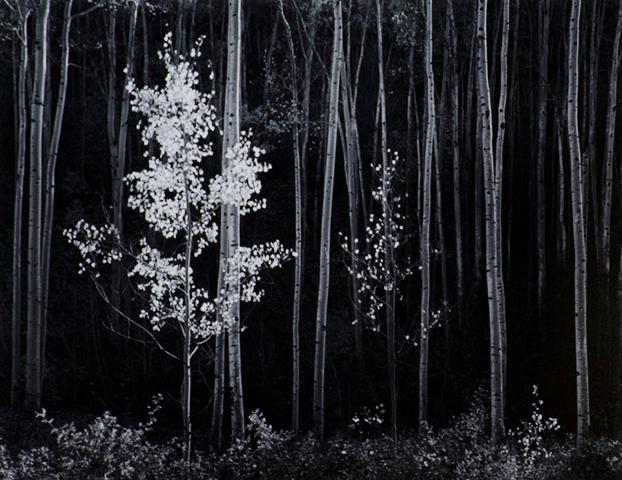
May 24 - July 2, 2021
Virtual exhibition
Ansel Adams, Aspens, New Mexico, 1958, 1958, gelatin silver print, de Saisset Museum permanent collection, Santa Clara University, Focus Gallery Collection, Helen Johnson Bequest, 6.4.1989
Drawing upon photographs from the de Saisset Museum's permanent collection, students in the Winter 2021 course Art History 140: Photography in the U.S., taught by Associate Professor Andrea Pappas, developed the following virtual exhibitions.
Learn more about the process of developing these virutal exhibitions by clicking the expanding headlines below to read introductions provided by Pappas and Lauren Baines, the de Saisset Museum's Interim Director.
The students in my winter 2021 course, Art History 140: Photography in the US, put together these online exhibitions for their term projects. Each small group of students chose approximately six photographs from a list of about 60 that I had pre-assembled as the “collection” from which to build their project. This mini-collection was drawn from the much larger collection of photographs held by SCU’s de Saisset Museum. Art history has as its central tenet the value of the first-hand encounter with the object, something that the pandemic made impossible to do this year. However, I still wanted students to engage with each other and with our campus museum not just to further their learning, but also to create a sense of community in our classroom, something we have all been missing in this year of extreme environmental challenges, of which the pandemic is but one. Each group worked to develop a topic for their exhibition based on common interests, and the final project consisted of the material you see here: an exhibition essay, didactic labels, and an installation diagram—to be accompanied by an explanation of their proposed arrangement of photographs in one of the museum galleries. This latter required reckoning with the way that museum installations create an argument or narrative in three dimensions, often with purely visual means. These elements comprise the building blocks of any exhibition. This project thus provided practical experience for students as they worked back and forth between the initial conception for their project, research, personal responses to the photographs, considerations of the audience for these exhibitions, and the demands of writing for different formats.
Students took a variety of approaches to the assignment, some produced scholarly historical narratives, grounded in extended research. Others interpreted their photographs in a more personal manner, reading the works metaphorically as well as historically. Students brought a range of skills in writing, research, and teamwork to the project. The projects vary widely, as diverse student interests, studies, and voices produced them. Yet, some underlying themes run through the group as a whole. Specifically, compassion for others surfaces in the way several of these projects address the prolonged isolation of this pandemic year, the work of social justice features in student analyses of images of people, and the pursuit of environmental sustainability drives student approaches to landscape photography. Here we see Santa Clara University’s core values in action.
I am grateful to my students for placing their trust in me and in each other—for many of them, ARTH 140 was their first encounter with art history and this kind of project was therefore completely unknown terrain. I also thank the de Saisset Museum staff members, especially Morgan Schlesinger (Collections Manager) and Lauren Baines (Interim Director); this valuable experience would not have been possible without their support of this project and of our students
- Andrea Pappas, Associate Professor, Department of Art & Art History
The de Saisset Museum prides itself on the ability to engage SCU students in its exhibitions and permanent collection through class visits and tours, educational programming, access to the permanent collection objects, and varied opportunities for classroom connections and student employment.
Amidst the pandemic, and a fully remote educational experience for most students, the de Saisset Museum sought new ways to engage Santa Clara University students. From virtual walk-throughs of our exhibitions, to live-streamed artist talks and studio visits, to Zoom class meetings in which students were introduced to collection items and shown behind-the-scenes at the museum, we collaborated with faculty to find ways to bring the museum to students in the digital sphere.
In partnership with Associate Professor Andrea Pappas for the Winter 2021 course, Art History 140: Photography in the U.S., we developed a completely new model for engaging students in the process of curation and exhibition development -- a structure that, while precipitated by the remote learning scenario, offers a template for expanded engagement of SCU students in the curation process for years to come.
Working from high-resolution images of photographic works in the de Saisset’s permanent collection, students in ARTH140 studied, discussed, and researched the photographs from our collection and ultimately curated the virtual exhibitions linked below. Their resulting essays and exhibition labels offer exciting analyses of both well-known and little known works of photography, and collectively underscore the relevancy of these photographs to contemporary audiences and current-day conversations. Their installation diagrams and descriptions anticipate how the artworks might relate to one another in the physical galleries of the de Saisset Museum.
While past exhibitions at the de Saisset featured student contributions in research, label writing, and installation, the exhibitions typically still featured museum staff, SCU faculty, or guest scholars in the role of curator. This course project marks the first fully student-developed exhibitions and the first fully virtual exhibitions by students.
Even as future classes resume face-to-face and students can again visit the museum to see collection objects in-person, the model of a virtual exhibition curated by students remains a viable course project, and thereby dramatically increases the possibilities for engaging larger numbers of students in the curatorial process in any given academic year. As such, while this project may be the first, we foresee that it is not the last!
- Lauren Baines, Interim Director, de Saisset Museum
Click an image below to visit the corresponding student-curated virtual exhibition.
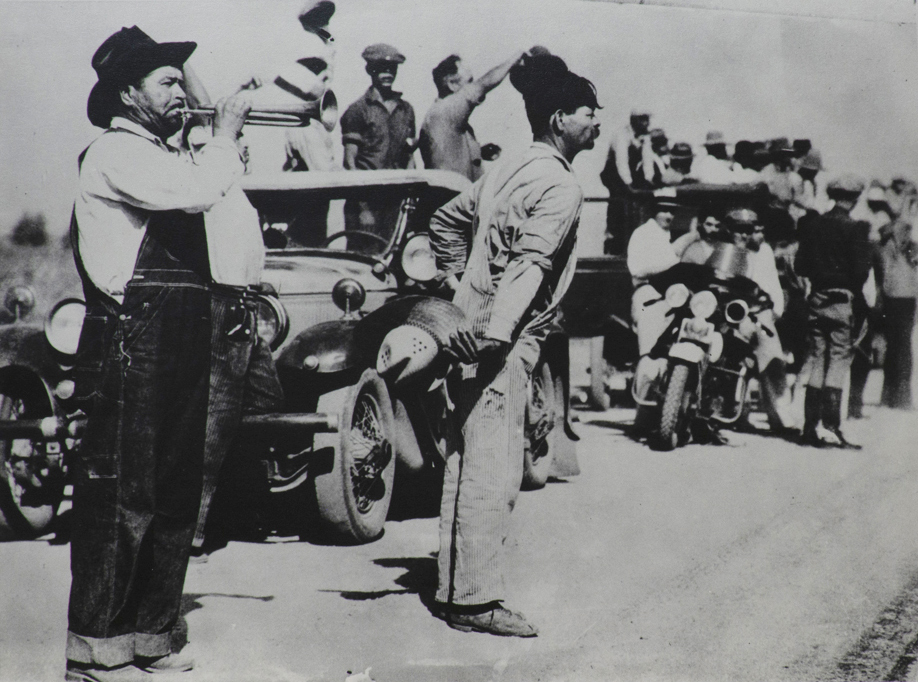
An exhibition focused on photographs that have constructed social concepts around the urban and rural landscape.
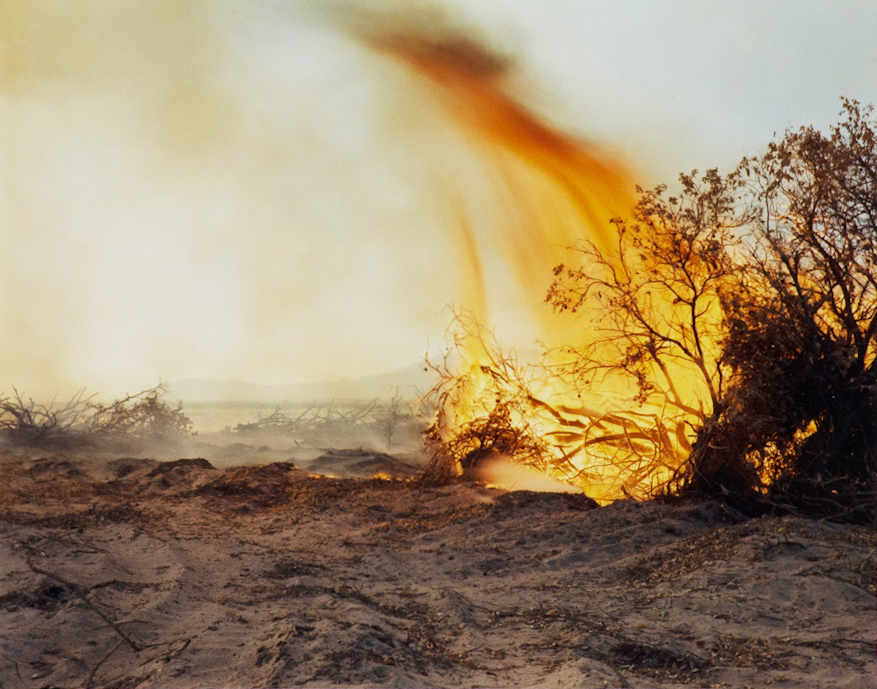
An exhibition utilizing landscape photography to tell a story of vulnerability as a process of degradation, healing, and scars.
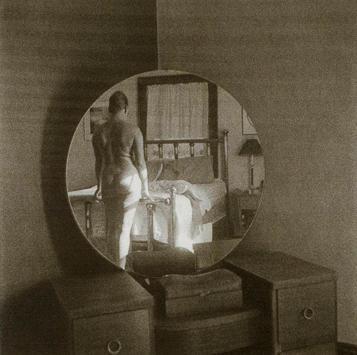
An exhibition contending with the varying levels of objectification and sexualization of women through the photographic medium.
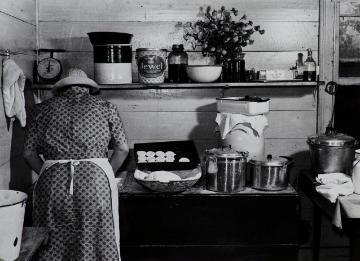
An exhibition exploring the various ways in which women are portrayed and represented through the form of portrait photography.
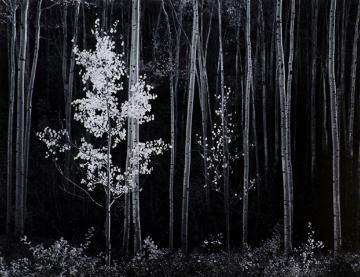
An exhibition delving into the impact and legacy of Manifest Destiny in the western portion of the United States through a series of photographs.
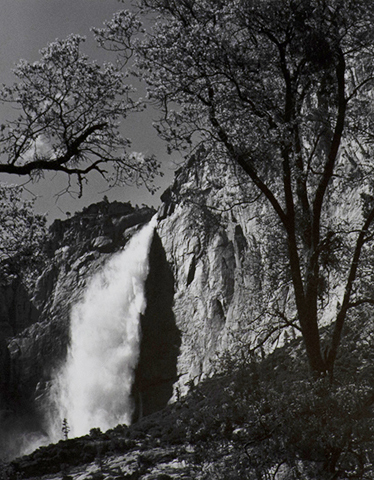
An exhibition focusing on how different photographers represent different kinds of relationships between people and the landscape.
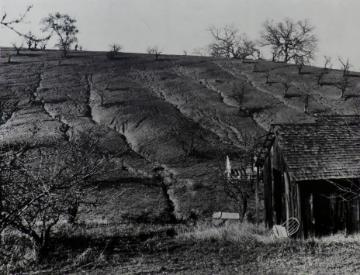
An exhibition of landscape photographs that seeks to connect art to loneliness and therefore the pandemic.
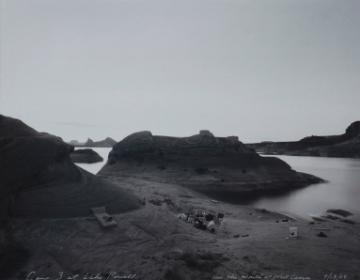
At the end of developing these exhibitions, we asked students to reflect on what they learned in the process. Their responses speak to the power of photography (and of photographers) in shaping how we see elements of our world, the important role art history plays in placing art and media into context, and a new appreciation for the work that goes into curation and exhibition design.
Image above: Mark Klett, Camp 3 at Lake Powell, 1984, gelatin silver print, de Saisset Museum permanent collection, Santa Clara University, Gift of David B. Devine, 1991.2.6
